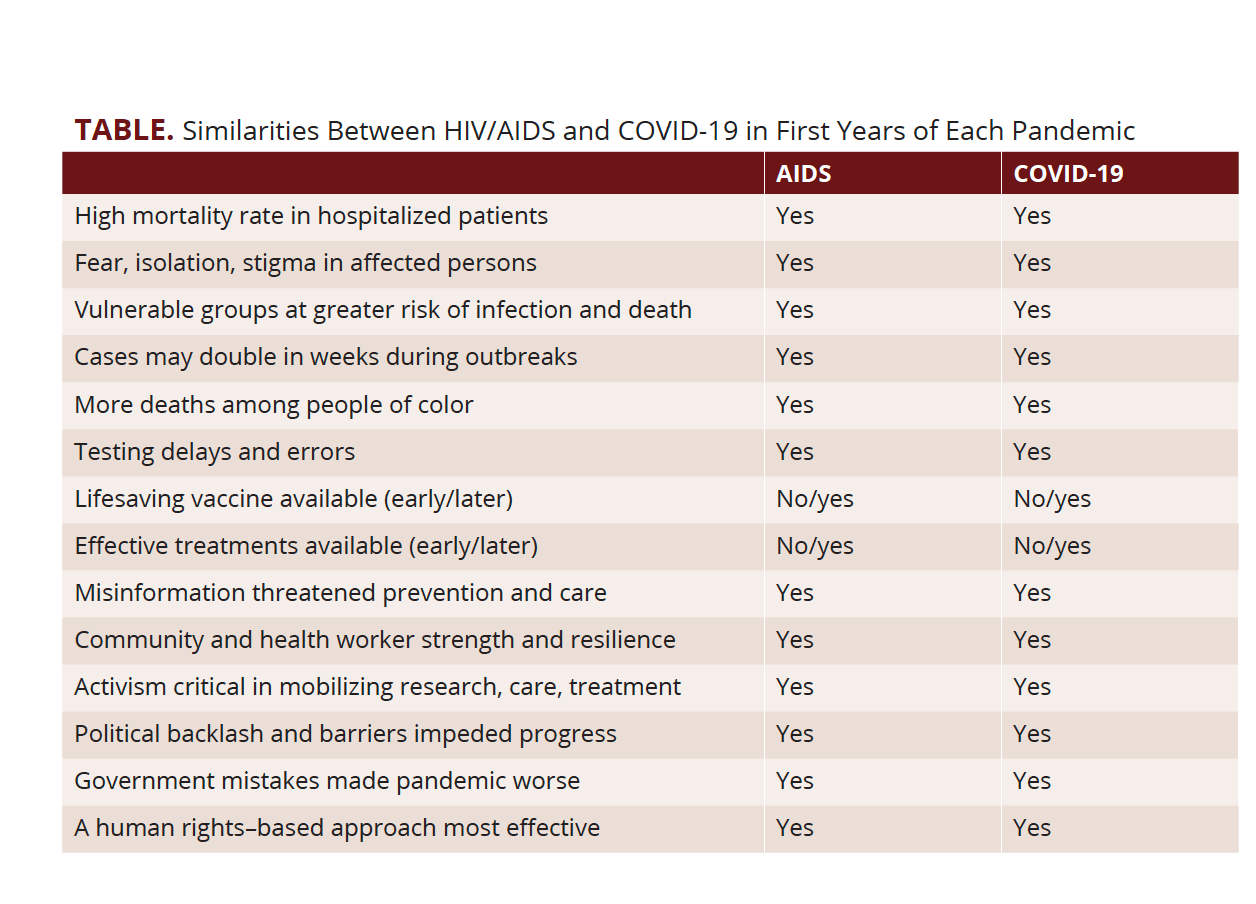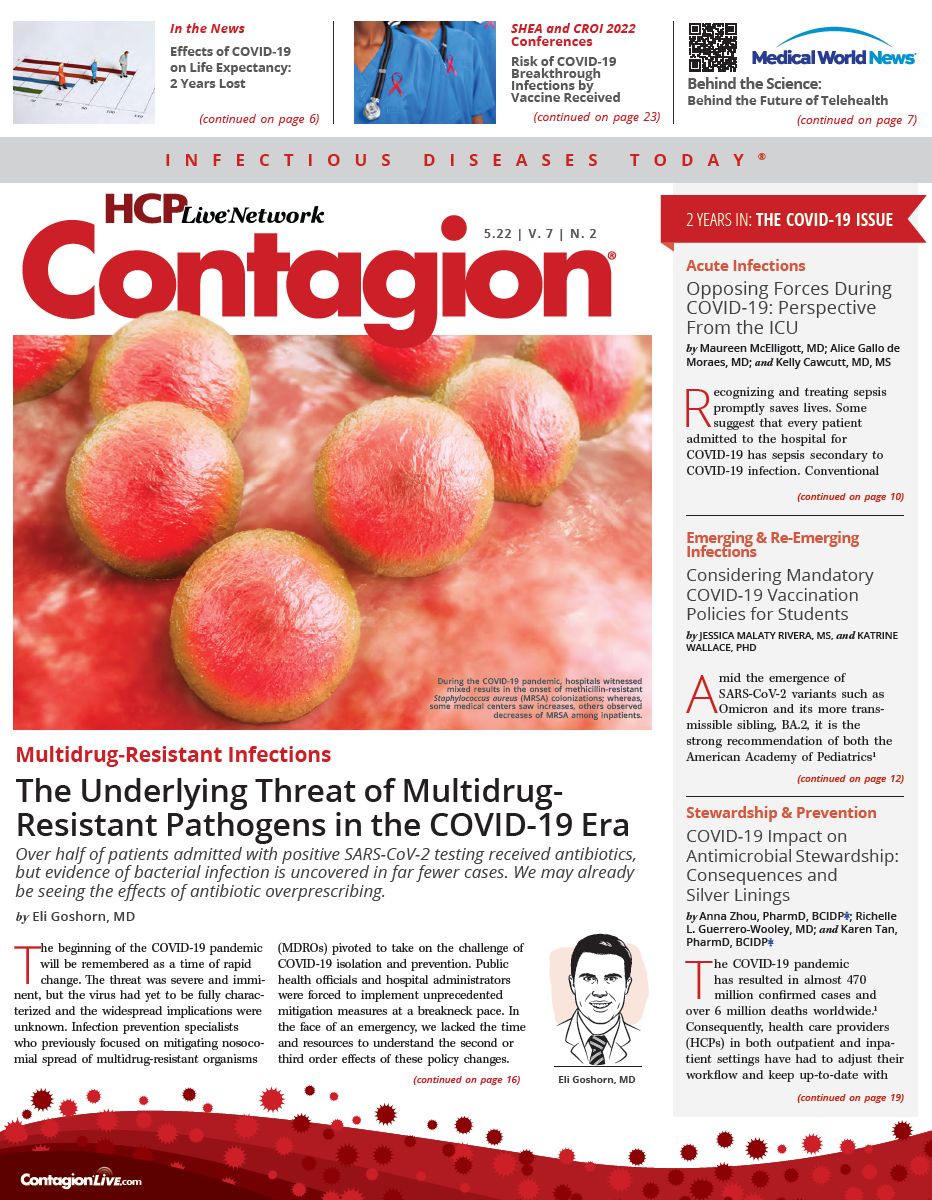Lessons in Resilience: What HIV Teaches Us About COVID-19
Four lessons learned from the AIDS crisis that can be applied to the fight against our current pandemic.
“The farther back you look, the farther forward you are likely to see.”
—Winston Churchill
Churchill’s words of wisdom impress upon us the value of reflecting— in this case, on the AIDS crisis for guidance with COVID-19. The resilience and solidarity of health care workers who have risen to the challenges of COVID-19 have been a source of inspiration worldwide. Many health workers had never experienced caring for patients with a new and potentially fatal contagious illness before COVID-19. Yet, there were many similarities between these 2 pandemics in their early years (Table).
We offer these lessons from HIV to inform our next steps in the development of best practices in care, prevention, and support for people with SARS-CoV-2 infection and other emerging pandemics in the future.

Important differences also exist between HIV and COVID-19. As of May 3, 2022, almost 1 million individuals had died from COVID-19 in the United States, and more than 700,000 people had died from HIV-related diseases.1,2 As a blood-borne and body fluid–borne pathogen, HIV affected only a small portion of the US population through sexual exposure, needle sharing, or blood products; however, HIV is more widespread worldwide due to greater heterosexual spread.3 The cumulative mortality from HIV in the US, while significant, pales vs the global toll of 37.5 million deaths.4 COVID-19, a respiratory pathogen, has affected major portions of populations globally, and the US has one of the highest national COVID-19 death rates.
Our review uses a human rights–based approach that values inclusion, fairness, and equity, eg, equal global access to antiretroviral therapies and COVID-19 vaccines. This perspective offers the best way to understand, prevent, and treat COVID-19 and to address the inequities among vulnerable populations.3 It also defines health broadly to include adequate housing, nutrition, a healthy environment, and respect for the rights of women, LGBTQ+ persons, and communities of color. Jonathan Mann, MD, Paul Farmer, MD, and others taught us that human rights are essential in the fight against HIV and HIV stigma, and these rights are equally critical for COVID-19.5-7
LESSON 1: BE FLEXIBLE, COLLABORATE, AND THINK OUTSIDE THE BOX
The early days of AIDS were fearful; an unknown illness with no known treatment was causing young Americans to die. The majority were men who have sex with men and people who inject drugs and their sexual partners, and Black and Latino Americans were disproportionately affected. Stigma and discrimination were widespread.8
People living with HIV (PLWHIV) not only suffered medical challenges, but also had profound psychosocial needs. In response, new clinical alliances formed, bringing together health educators, pharmacists, case managers, drug and mental health counselors, and community health workers.9 These interdisciplinary teams included PLWHIV and led to innovations in treatment and research. A key lesson from HIV was that transportation, childcare, and mental health services were often as important to PLWHIV as effective medications.10
Flexibility and innovation also have been essential to the COVID-19 response. During the initial wave, hospitals quickly reorganized wards into COVID-19 units and reassigned staff to testing sites, lab services, and COVID-19 care teams.11 The care and research communities pivoted nimbly to address these changing needs; for example, multidisciplinary clinics have been developed for long COVID-19.
As COVID-19 transitions from a pandemic to an endemic state, it is leaving behind a trail of social and economic devastation, with mental illness and homelessness on the rise.12 Continued collaboration and creative problem solving to support those impacted will be critical.
LESSON 2: PREVENT BURNOUT AND DEVELOP EFFECTIVE RESILIENCE STRATEGIES
Prior to combination antiretroviral therapy in 1995, the AIDS death toll was staggering.8 Due to the stigma and fear surrounding HIV, many patients died without friends and family at their bedside. Similarly, hospital visitor policies during COVID-19 limited friend and family contact to telecommunications. With COVID-19, although some health workers were reassigned due to age or underlying conditions, the majority were needed to care for the overwhelming number of patients in emergency departments, wards, and intensive care units (ICUs). Early in the HIV pandemic, many health workers refused to work with HIV patients, and a small group of committed providers cared for PLWHIV. In contrast to the tsunami of COVID-19 waves, the HIV epidemic was a relentlessly growing crisis in slow motion. Nonetheless, in both pandemics, caring for a relentless daily stream of very sick and dying patients took a major emotional toll on caregivers.
Burnout was common in the first decade of AIDS, and COVID-19 is having a similar impact. Recently, two-thirds of ICU nurses were considering leaving nursing due to COVID-19 burnout.13 To cope with burnout, AIDS caregivers established support groups, memorial services, community linkages, and a range of health worker supports.14-16 However, with COVID-19 restrictions since 2020, similar strategies have been challenging to implement. Staffing shortages and high health worker dissatisfaction with COVID-19 are an alarming call for us to learn from past experience to improve working conditions and support our workforce with wellness programs that promote resilience.
LESSON 3: ADVOCATE AND NETWORK TO FIGHT MISINFORMATION AND TOXIC POLITICS
Both the COVID-19 and HIV pandemics have been embroiled in toxic politics. The media stoked the public’s fear of HIV with sensationalized reporting that further stigmatized PLWHIV. Politicians demanded that PLWHIV be barred from some occupations and children with HIV be kept from school, even when science established a negligible risk of transmission. The US government’s early response to HIV was inadequate and underfunded, leaving advocacy groups such as the AIDS Coalition to Unleash Power, or ACT UP, and the AIDS Foundation of Chicago to organize grassroots campaigns to help care for PLWHIV and fight for their rights. Through community engagement and aggressive political advocacy, the Ryan White Comprehensive AIDS Resources Emergency Act was implemented to support HIV services and medications for Americans with low incomes.
Today’s polarized political landscape has resulted in a bewildering and irrational range of health policies regarding masking in schools and public spaces, vaccine mandates, and access to COVID-19 testing and therapies. Shockingly, the White House was the most common source of COVID-19 misinformation in 2020.17 Social media was absent in the early HIV era, but it is a virulent source of misinformation about COVID-19 that seriously hampered early efforts to prevent further spread and reduce mortalities.17 Our right to share in free speech and scientific advances includes the responsibility to harness social media as a powerful tool for accurate information, stigma reduction, and community engagement.
Early in the HIV epidemic, HIV clinicians, scientists, and advocates shared their experiences and research at international conferences. These meetings were invaluable for networking with the global HIV community and promoting solidarity for marginalized groups such as LGBTQ+, women at risk, and people of color. Like HIV clinicians, health workers today should continue to network, collaborate, and share stories of inspiration and support to advocate for the safety of our patients and our own well-being and to stay up-to-date during this rapidly evolving pandemic.
LESSON 4: PROGRESS AND SCIENTIFIC DISCOVERY ARE THE SILVER LININGS AND WAY FORWARD
HIV and COVID-19 have attracted an astonishing volume of research interest and scientific productivity. In one survey, 40% of physicians who cared for patients with HIV reported increased levels of intellectual stimulation and career satisfaction.18 Similarly, a study of physicians who cared for patients with AIDS found that AIDS care also became an opportunity to connect more deeply with themselves and to enact the values of their profession.19 These are hopeful trends for today’s exhausted COVID-19 caregivers.
HIV research led to innumerable scientific discoveries, such as antiretroviral therapies, electron microscopy, immune modulators, genomic sequencing, and chimeric antigen receptor T-cell therapies, which changed the course of previously fatal diseases.20 The pace of scientific progress in all fields has greatly accelerated, as exemplified by access to almost real-time data on the number of new cases. mRNA vaccine technology and advances in pangenotypic COVID-19 vaccine research are promising future innovations.
Our world is almost unrecognizable, as fear, unease, and politically polarized battles have become the new norm. Too often, we forget the most profound of our human rights—the responsibility to remember the lessons of past pandemics and to act in the interest of public health to prevent their recurrence. In the 1990s, PLWHIV, activists, and health workers fought ferociously to demand that all lives be valued equally and insisted that lifesaving antiretroviral therapy be provided to all PLWHIV in the world. Similar voices in the COVID-19 pandemic are working to expand equal care and treatment globally and to demand equitable access to COVID-19 vaccines.
As with HIV, the battle against COVID-19 will be won with science, sound public health, and broad implementation of a human rights approach. It is essential that we achieve global equity in access to COVID-19 personal protective equipment, testing, vaccines, and treatments to overcome the scourge of COVID-19 and the inequities that it has exposed. The lessons learned from the early HIV era remain essential for both HIV and COVID-19 today: Our greatest asset is our collective strength to collaborate and advocate for effective accessible health services and policies that are based on science and the fundamental human right to dignity and health.
References
1. COVID data tracker. CDC. Updated March 28, 2022. Accessed March 28, 2022. https://covid.cdc.gov/covid-data-tracker
2. Statistics overview. CDC. Updated February 28, 2022. Accessed March 28, 2022. https://www.cdc.gov/hiv/statistics/overview/index.html
3. Kilmarx, PH. Current Opinion in HIV and AIDS. 2009;4:240-246. doi:0.1097/COH.0b013e32832c06db
4. UNAIDS. Global HIV and AIDS Statistics – Fact Sheet. Accessed 4.13.22. https://www.unaids.org/en/resources/fact-sheet
5. Jonathan M. Mann, Lawrence Gostin, Sofia Gruskin, Troyen Brennan, Zita Lazzarini, Harvey Fineberg. Health and Human Rights. In: Mann JM, Gruskin S, Grodin MA, Annas GJ, eds. Health and Human Rights. Routledge; 1999:7-20.
6. Paul Farmer. Rethinking Health and Human Rights. In: Saussy H, ed. Partner to the Poor. University of California Press; 2010:213-247.
7. Alicia Eli Yamin. Dignity and Suffering: Why Human Rights Matter. In: Alicia Eli Yamin. Power, Suffering, and the Struggle for Dignity. University of Pennsylvania Press; 2016:25-48.
8. CDC. The AIDS Epidemic in the United States, 1981-early 1990s. Accessed 4.13.22. https://www.cdc.gov/museum/online/story-of-cdc/aids/index.html
9. Dykeman MC, Sternberg C, Jasek J, et al. A model for the delivery of care for HIV-positive clients. AIDS Patient Care STDS. 1996;10(4):240-245. doi:10.1089/apc.1996.10.240
10. Sherer R, Stieglitz K, Narra J, et al. HIV multidisciplinary teams work: support services improve access to and retention in HIV primary care. AIDS Care. 2002;14(suppl 1):S31-S44. doi:10.1080/09540120220149975
11. Zhang A, GoodSmith M, Server S, et al. Providing support during a pandemic: a medical student telehealth service for ambulatory patients with COVID-19. Healthc (Amst). 2022;10(1):100612. doi:10.1016/j.hjdsi.2022.100612
12. The impact of the COVID-19 pandemic on homelessness in the United States. United Way of the National Capital Area. January 12, 2021. Accessed April 1, 2022.https://unitedwaynca.org/blog/the-impact-of-the-covid-19-pandemic-on-homelessness-in-the-united-states
13. Here Us Out campaign reports nurses’ COVID-19 reality. News release. American Association of Critical-Care Nurses. September 21, 2021. Accessed March 28, 2022. https://www.aacn.org/newsroom/hear-us-out-campaign-reports-nurses-covid-19-reality
14. McKusick L, ed. What to Do About AIDS: Physicians and Mental Health Professionals Discuss the Issues. University of California Press; 1986.
15. Bellani ML, Furlani F, Gnecchi M, Pezzotta P, Trotti EM, Bellotti GG. Burnout and related factors among HIV/AIDS health care workers. AIDS Care. 1996;8(2):207-222. doi:10.1080/09540129650125885
16. Sherman DW, Ouellette SC. Physicians reflect on their lived experiences in long-term AIDS care. J Palliat Med. 2000;3(3):275-286. doi:10.1089/jpm.2000.3.275
17. Evanaga S, Lynas M, Adams J, Smolenyak K. Coronavirus misinformation: quantifying sources and themes in the COVID-19 ‘infodemic.’ Alliance for Science. July 23, 2020. Accessed April 12, 2022. https://allianceforscience.cornell.edu/wp-content/uploads/2020/10/Evanega-et-al-Coronavirus-misinformation-submitted_07_23_20-1.pdf
18. Bayer R, Oppenheimer G. Aids Doctors: Voices From the Epidemic: An Oral History. Oxford University Press; 2000.
19. amFar, the Foundation for AIDS Research. AIDS at 30: A relentless search for answers. June 3, 2011. Accessed April 13, 2022. https://www.amfar.org/news/aids-at-30-a-relentless-search-for-answers/
20. Schwetz TA, Fauci AS. The extended impact of human immunodeficiency virus/AIDS research. J Infect Dis. 2019;219(1):6-9. doi:10.1093/infdis/jiy441

